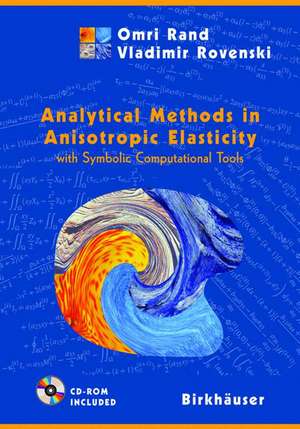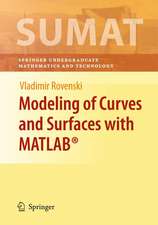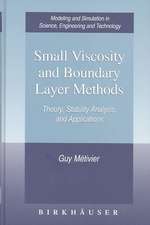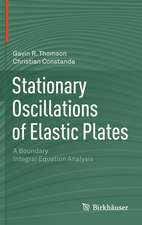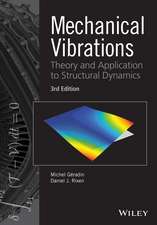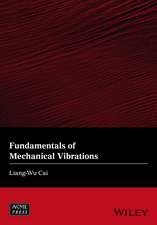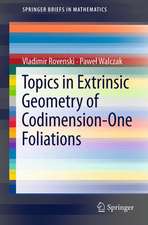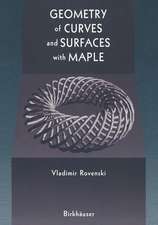Analytical Methods in Anisotropic Elasticity: with Symbolic Computational Tools
Autor Omri Rand, Vladimir Rovenskien Limba Engleză Paperback – 28 oct 2004
Preț: 406.05 lei
Nou
Puncte Express: 609
Preț estimativ în valută:
77.70€ • 81.34$ • 64.29£
77.70€ • 81.34$ • 64.29£
Carte tipărită la comandă
Livrare economică 05-19 aprilie
Preluare comenzi: 021 569.72.76
Specificații
ISBN-13: 9780817642723
ISBN-10: 0817642722
Pagini: 451
Ilustrații: XVIII, 451 p. 167 illus. With online files/update.
Dimensiuni: 178 x 254 x 23 mm
Greutate: 0.84 kg
Ediția:2005
Editura: Birkhäuser Boston
Colecția Birkhäuser
Locul publicării:Boston, MA, United States
ISBN-10: 0817642722
Pagini: 451
Ilustrații: XVIII, 451 p. 167 illus. With online files/update.
Dimensiuni: 178 x 254 x 23 mm
Greutate: 0.84 kg
Ediția:2005
Editura: Birkhäuser Boston
Colecția Birkhäuser
Locul publicării:Boston, MA, United States
Public țintă
Professional/practitionerCuprins
Fundamentals of Anisotropic Elasticity and Analytical Methodologies.- Anisotropic Materials.- Plane Deformation Analysis.- Solution Methodologies.- Foundations of Anisotropic Beam Analysis.- Beams of General Anisotropy.- Homogeneous, Uncoupled Monoclinic Beams.- Non-Homogeneous Plane and Beam Analysis.- Solid Coupled Monoclinic Beams.- Thin-Walled Coupled Monoclinic Beams.- Program Descriptions.
Recenzii
From the reviews:
"The book emphasizes the applications of analytical methods in the solutions of boundary value problems (BVPs) in anisotropic elasticity, but the focus is on the procedure of obtaining analytical solutions. It starts with a condensed, mathematically flavored summary of basics of anisotropic elasticity in the first 4 chapters. The primary methods, the global polynomial analysis and the method of complex potentials are then introduced. The methods are applied to various two dimensional and three dimensional BVPs, with a focus on beams with different levels of anisotropy. A feature of this book is that the solution for each type of problems is preceded with a complete mathematical formulation of the BVP. It also contains many solved problems and an extensive list of references. It should be noted that the authors do not discuss how to use symbolic computational tools. The book can be used as a reference for those who are familiar with the theory of elasticity and are interested in analytical solutions of BVPs in anisotropic elasticity."--MATHEMATICAL REVIEWS
“The book is intended to be a self-contained reference for the topic and aimed at practicing engineers who put the analytical approaches for anisotropic elasticity problems to practical use. Graduate, postgraduate and doctoral students of mechanical engineering could benefit from using the book as well. This well-written book is a reader-friendly and well organized handbook in the field of anisotropic elasticity. It can be highly recommended for experts in Mechanics of Solids, engineers, and for graduate, postgraduate and doctoral students.”(ZENTRALBLATT MATH)
"The book emphasizes the applications of analytical methods in the solutions of boundary value problems (BVPs) in anisotropic elasticity, but the focus is on the procedure of obtaining analytical solutions. It starts with a condensed, mathematically flavored summary of basics of anisotropic elasticity in the first 4 chapters. The primary methods, the global polynomial analysis and the method of complex potentials are then introduced. The methods are applied to various two dimensional and three dimensional BVPs, with a focus on beams with different levels of anisotropy. A feature of this book is that the solution for each type of problems is preceded with a complete mathematical formulation of the BVP. It also contains many solved problems and an extensive list of references. It should be noted that the authors do not discuss how to use symbolic computational tools. The book can be used as a reference for those who are familiar with the theory of elasticity and are interested in analytical solutions of BVPs in anisotropic elasticity."--MATHEMATICAL REVIEWS
“The book is intended to be a self-contained reference for the topic and aimed at practicing engineers who put the analytical approaches for anisotropic elasticity problems to practical use. Graduate, postgraduate and doctoral students of mechanical engineering could benefit from using the book as well. This well-written book is a reader-friendly and well organized handbook in the field of anisotropic elasticity. It can be highly recommended for experts in Mechanics of Solids, engineers, and for graduate, postgraduate and doctoral students.”(ZENTRALBLATT MATH)
Notă biografică
Omri Rand is a Professor of Aerospace Engineering at the Technion – Israel Institute of Technology. He has been involved in research on theoretical modeling and analysis in the area of anisotropic elasticity for the last fifteen years, he is the author of many journal papers and conference presentations in this area. Dr. Rand has been extensively active in composite rotor blade analysis, and established many well recognized analytical and numerical approaches. He teaches graduate courses in the area of anisotropic elasticity, serves as the Editor-in-Chief of Science and Engineering of Composite Materials, as a reviewer for leading professional journals, and as a consultant to various research and development organizations.
Vladimir Rovenski is a Professor of Mathematics and a well known researcher in the area of Riemannian and computational geometry. He is a corresponding member of the Natural Science Academy of Russia, a member of the American Mathematical Society, and serves as a reviewer of Zentralblatt für Mathematik. He is the author of many journal papers and books, including Foliations on Riemannian Manifolds and Submanifolds (Birkhäuser, 1997), and Geometry of Curves and Surfaces with MAPLE (Birkhäuser, 2000). Since 1999, Dr. Rovenski is a senior scientist at the faculty of Aerospace Engineering at the Technion – Israel Institute of Technology, and a lecturer at Haifa University.
Vladimir Rovenski is a Professor of Mathematics and a well known researcher in the area of Riemannian and computational geometry. He is a corresponding member of the Natural Science Academy of Russia, a member of the American Mathematical Society, and serves as a reviewer of Zentralblatt für Mathematik. He is the author of many journal papers and books, including Foliations on Riemannian Manifolds and Submanifolds (Birkhäuser, 1997), and Geometry of Curves and Surfaces with MAPLE (Birkhäuser, 2000). Since 1999, Dr. Rovenski is a senior scientist at the faculty of Aerospace Engineering at the Technion – Israel Institute of Technology, and a lecturer at Haifa University.
Textul de pe ultima copertă
This comprehensive textbook/reference focuses on the mathematical techniques and solution methodologies required to establish the foundations of anisotropic elasticity and provides the theoretical background for composite material analysis. Specific attention is devoted to the potential of modern symbolic computational tools to support highly complex analytical solutions and their contribution to the rigor, analytical uniformity and exactness of the derivation.
Key features:
* Refreshes and modernizes classical mathematical methods encountered in the theory of anisotropic elasticity
* Reviews basic and advanced steps of general analytical solutions, including the initial assumptions and selection of an adequate analytical course
* Demonstrates the potential of symbolic computational tools to support the development of analytical solutions and to verify their exactness
* Examines the physical interpretation of exact and approximate mathematical solutions and provides important insight into the involved phenomena
* Provides state-of-the-art solutions for a wide range of cases, including non-homogeneous and thin-walled configurations
Analytical Methods in Anisotropic Elasticity will appeal to a broad audience involved in mathematical modeling, all of whom must have good mathematical skills: graduate students and professors in courses on elasticity and solid-mechanics labs/seminars, applied mathematicians and numerical analysts, scientists and researchers. Engineers involved in aeronautical and space, maritime and mechanical design of composite material structures will find this an excellent hands-on reference text as well. All will benefit from the classical and advanced solutions that are derived and presented using symbolic computational techniques.
Key features:
* Refreshes and modernizes classical mathematical methods encountered in the theory of anisotropic elasticity
* Reviews basic and advanced steps of general analytical solutions, including the initial assumptions and selection of an adequate analytical course
* Demonstrates the potential of symbolic computational tools to support the development of analytical solutions and to verify their exactness
* Examines the physical interpretation of exact and approximate mathematical solutions and provides important insight into the involved phenomena
* Provides state-of-the-art solutions for a wide range of cases, including non-homogeneous and thin-walled configurations
Analytical Methods in Anisotropic Elasticity will appeal to a broad audience involved in mathematical modeling, all of whom must have good mathematical skills: graduate students and professors in courses on elasticity and solid-mechanics labs/seminars, applied mathematicians and numerical analysts, scientists and researchers. Engineers involved in aeronautical and space, maritime and mechanical design of composite material structures will find this an excellent hands-on reference text as well. All will benefit from the classical and advanced solutions that are derived and presented using symbolic computational techniques.
Caracteristici
Comprehensive textbook/reference applies mathematical methods and modern symbolic computational tools to anisotropic elasticity Presents unified approach to a vast diversity of structural models State-of-the-art solutions are provided for a wide range of composite material configurations, including: 3-D anisotropic bodies, 2-D anisotropic plates, laminated and thin-walled structures
